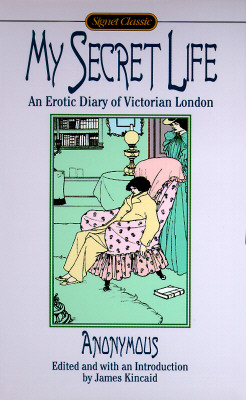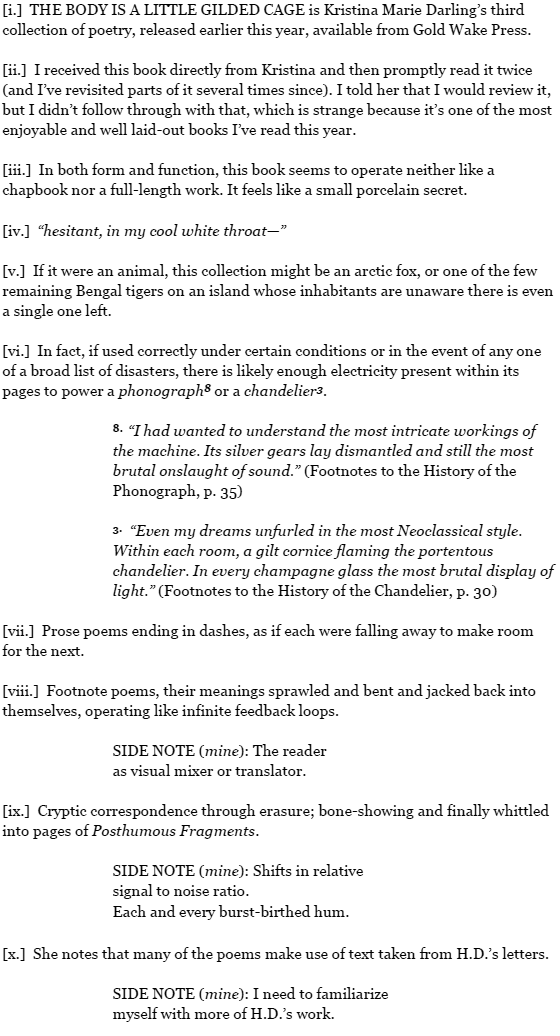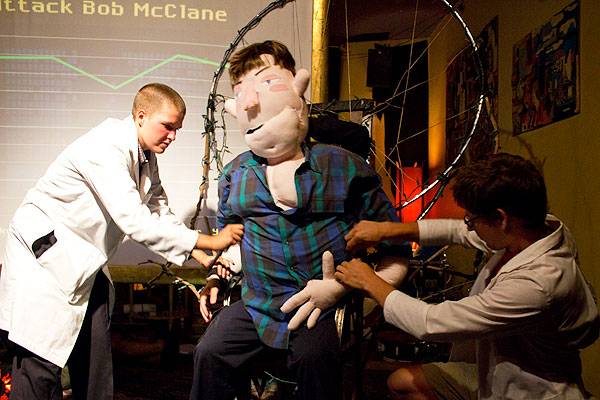Crowd Sourcing Question: What are the essential texts of third wave feminism?
Helpful suggestions greatly appreciated. I’m trying to put together a research list, and thought others might also be interested.
I posed this question on Facebook last week, and I got some good recommendations. I also got a sense that there’s some confusion over what constitutes “third wave.” (Does Camille Paglia “count”?) While I have a general idea about the distinctions between first, second, and third wave, I’d like to be more familiar with the important works that contribute to this specific conversation.
So here are the suggestions I received via Facebook…please help to increase and/or complicate the list…many thanks…
25 Points: The Body is a Little Gilded Cage: A Story in Letters and Fragments
 The Body is a Little Gilded Cage: A Story in Letters and Fragments
The Body is a Little Gilded Cage: A Story in Letters and Fragments
by Kristina Marie Darling
Gold Wake Press, 2012
56 pages / $12.95 buy from Amazon
November 13th, 2012 / 9:09 am
I’m sorry, Mario, but your cultural critique is in another castle: some thoughts on hipster irony
Last August I attended a live reenactment of Total Recall (the classic 1990 version, natch, not the remake). It was a deliberately shambolic affair, a loosely-focused variety show run by Everything Is Terrible and Odds N’ Ends, involving puppets, videos, intentionally bad acting, and dancing. It was, I suppose, what some would call “hip” or “ironic.”
At one point we watched a reedited version of one Total Recall‘s many chase scenes—the infamous escalator shootout where Arnold uses a bystander as a shield—now set to Drowning Pool’s “Bodies.” (You can watch the video here.) Which is about as cliched as it gets, but it totally works as comedy.
Part of what makes the video funny is that the Everything Is Terrible folks have upped the intensity of the Drowning Pool song: “Let the bodies hit the floor, let the bodies hit the floor … Oh, wait, they’re totally stepping on that dead guy’s squishy body—ick.” Here we must pause responsibly to acknowledge that Drowning Pool frontman David Williams has always stated that the song is not actually about “the violence thing,” but rather the “respect and code” of the mosh pit, or some such other bullshit. That hasn’t stopped Hollywood folk from using the song in numerous action movie trailers. Nor has it deterred legions of Drowning Pool fans from making their own YouTube versions.
In other words, the Everything Is Terrible video’s ironic effect depends on the pairing being a cliché. Like a lot of satirical and ironic art, it proceeds by imitating an otherwise naïve or sincere effect, then subverting it. (This is why “irony vs. sincerity” is often an unhelpful binary when thinking about phenomena like hipster irony or the New Sincerity; those scenes or movements aren’t strict artistic opposites, since they necessarily share a lot of their aesthetic maneuvers. Where they differ usually lies more in their degree of self-effacement, and in their authorial intention.)
Hipster irony is commonly perceived purely as dismissal: “You’re just making fun of Drowning Pool.” And there’s certainly truth in that—fuck Drowning Pool! But is that all there is? Because the EIT video, I think, and the entire Totally Recalled show, could be perceived as something more. Those behind the show, and those in attendance, I’d argue, were actually trying to appreciate “Bodies”—but in the only way they now can. Irony, in other words, allows hipster audiences to make use of material that would otherwise be off-limits to them.
It won’t surprise you that I want to turn here to Viktor Shklovsky, because he identified a concept that I think might help us. It is his concept of deterioration:
Seated Man

Ingres’ The Valpinçon Bather (1808) was originally known simply as “Seated Woman,” but was eventually come to be known by one of its 19th century owners Valpinçon, a bow to patronage’s constant finger in history. The painting may be seen as a more mature and restrained follow-up to Woman Bathing (1807), whose side-view titty shot and pronounced sexual imminence is argued, with many others like it, to have been the porn of that day. With the Valpinçon version, we only have the plush concavity of the sheets, barely burdened by her, caving in to her calm neutrality. Whether she looks elsewhere, or concedes to our gawk, is unknown. Baudelaire is to remark on her serene chastity, a contradiction to the overt sexuality of the rest of his female subjects. We are taught what is extreme by the very boundaries meant to be straddled, us sliding down the wrong side. Pornographic images essentially commemorate that such events actually happened; the fantasy is not contingent on its possibility, but actual manifestation. (I am a keen on outdoor sex by railroad tracks, preferably in Eastern “fallen” Europe, or the Balkans, whose culmination requires paper towels that are never around.) Shame (2011) follows an emo sex addict with a python dong who likes to jog to Bach and breaks down and cries, all under the Picasso blue period tint of lower Manhattan. He follows women home from the Metro and fucks them in the presumable pooper. He slams them against the glass wall panels in lush condos overlooking the Hudson. Through a disappointing homophobic lens, to convey just how fucked up he has gotten, our protagonist (Michael Fassbender) gets punched in the face and winds up in mysterious “gay underworld” lit by fuchsia lights, blowing or being blown, the up-close crooked handheld camera mimicking head bobbing motions. The secret to this laptop, and yours, is before facebook, nytimes, and weather channel, it’s the sad honesty of complete strangers fucking with more feigned professional conviction than real relationships could ever propose, or would ever dare to. This is the beauty of our kidnapped gaze. This morning, my legs splayed across a black Pier 1 dining chair, I saw a Japanese girl blow a fisherman (yeah, right) in the bait shack, his resuscitated dong under the costume of scintillating pixels, her lips exposing each solemn purple inch as she slowly withdrew with his child in her. Sex addiction is like saying food addiction: the biological need can easily justify the adandoned insanity of its consumption. My favorite scenes were of Fassbender on his pristine bed, the minimalist camera trusting the viewer enough to barely move, stoically wanking it to his black Dell laptop, whose averted screen, like Valpinçon’s face, begins to tell the story of what can’t be told.
The Weave and Werve of Words in William Gass’s On Being Blue: A Philosophical Inquiry
 On Being Blue: A Philosophical Inquiry
On Being Blue: A Philosophical Inquiry
by William Gass
D. R. Godine, 1975 / 1991
91 pages / Buy from Amazon (1975 ed / 1991 ed)
Monday is a good day to think about William Gass’s On Being Blue because Mondays often are. The color blue, Gass’s muse, is, in this slim book, organized, discussed, described, pondered, and psychoanalyzed; the first page is a list of just a few things that could be blue—stockings, movies, laws—and the last page is a fading away, these wild words all we have left, as “everything is gray.” From blue to gray to yellow and green and wherever in between, On Being Blue is a hopscotch around the rainbow. It infects you with synesthesia. There’s the “disapproving purse to pink”, “violet’s rapid sexual shudder,” and “the rolled-down sound in brown.” There are also lots of curse words and fucking.
(Some form of the word blue appears 412 times, according to my count.)
Not only fucking, there’s also “ficking,” “facking,” and “focking.” Blue is the color of obscenity-laced literature and balls. It’s a portal into the sexual, a catch-all color that captures the deliciously libertine, our deviant wants and protruding desires that in fiction are titillations of the imagination provoked through language. Gass turns sex into linguistic gymnastics, so he fascinates us with “not lips and nipples, but nouns and verbs.” Beautiful language is, to Gass, a great aphrodisiac. He quotes verse by Sir John Suckling and a scene from The Lime Twig. He pokes around Gertrude Stein’s Tender Buttons.
November 12th, 2012 / 12:00 pm
They’re going to make the National Book Awards dinner a flashy thing, like the Oscars/Man Booker: The goal is to add more sex appeal to an industry that’s not exactly known for it — but not, the organizers insist, just for its own sake. “It’s not about being glitzy,” said David Steinberger, the chief executive of Perseus Books and chairman of the foundation. “It’s about increasing the impact great books have on the culture.”
Q & A WITH TODD GRIMSON
Todd Grimson is one of the great living cult novelists. I’ve known him for a few years, under strange circumstances. He wrote Brand New Cherry Flavor, which is both one of my favorite horror novels and my favorite novel about Hollywood and the film industry. He also wrote the underground vampire classic Stainless. Both were recently re-released by Schaffner Press, which is now publishing his new collection of stories, Stabs at Happiness, in pleasing hardcover.
It’s a terrific collection, diverse and weird and disturbing. (Here are some reviews: Litbitch. The Oregonian. Gothic.net.) You can and should buy it.
I asked Todd some questions about Stabs at Happiness and about his strange life and career.
For a while, you assumed the name “I. Fontana” and published stories in BOMB, Juked, The Quarterly, Lamination Colony, Word Riot, PANK, the Voice Literary Supplement, Bikini Girl, Spork and many others. We corresponded for some time before I knew your real name. Why did you adopt that name?
Fontana comes from “Fontana Mix,” a composition by John Cage I heard when I was 13. READ MORE >
My Secret Life – An Erotic Diary of Victorian London (1902) – Selected Subheadings
 My aunt’s backside. – Haymaking frolics. – Romance and sentiment. – My father dies. – A wet dream. – My letch for a little one. – Funking consequences. – Nelly consents. – Fred looks on. – A saucy valet. – Low-class fucksters. READ MORE >
My aunt’s backside. – Haymaking frolics. – Romance and sentiment. – My father dies. – A wet dream. – My letch for a little one. – Funking consequences. – Nelly consents. – Fred looks on. – A saucy valet. – Low-class fucksters. READ MORE >
November 12th, 2012 / 5:20 am
Action, Yes
A couple of days ago, the latest installment of Action, Yes made its debut.
For those of you who aren’t already aware, Action, Yes is the online journal wing of Action Books, a pugnacious press operated by Johannes Göransson and Joyelle McSweeney, who happens to be the reigning brunette bombshell of 21st-century poetry.
Also, Action Books has published one of the most outrageous collections of poetry ever — a collection that manipulates language to enchanting extremes. This bold book is entitled Maxium Gaga. Its author is Lara Glenum.
Back to this edition of Action, Yes… it has many notable participants. I’m going to supply some of them with outfits.
First, I’ll dress the editors, Carina Finn and Jiyoon Lee.
Who Are The Tribes, by Terrance Hayes
Pilot Books publishes limited edition poetry chapbooks and comics from the likes of Matthew Zapruder, Mary Ruefle, and Jessica Fjeld. They contend that “innovative work demands innovative design,” so: “all of our books are designed and printed in ways unique and luminous to the manuscript itself. We take the editorial and design process as a seriously creative act, one that gives the poems an opportunity to live a physical life that the reader can interact with in new ways.”

They’ve been at it for five years. All of the books are beautiful, but none more beautiful than Who Are the Tribes, their latest offering, by Terrance Hayes. The book was produced in a limited letterpress edition of 300, bound in a double pamphlet handstitch, with illustrations (pen-and-ink drawings, it looks like) by the author.
The text is a single poem in 15 parts, and it is wild, formally and otherwise.
The first movement, “1. BEEFS,” begins with a spreadsheet in which the rows are delineated Tribe, Color, Poison, Smoke, Loves, and the columns are 1st, 2nd, 3rd, 4th, and 5th. Each tribe is given a name (ANTLER, SPIKE, QUIXOTE, BILL, and SIXFOUR) READ MORE >




